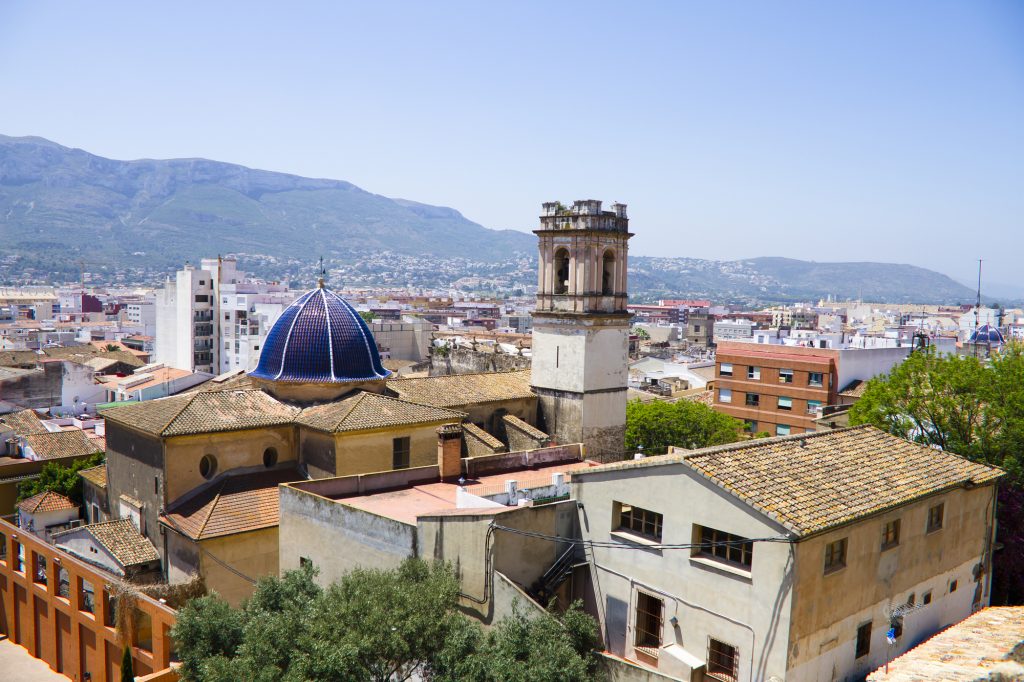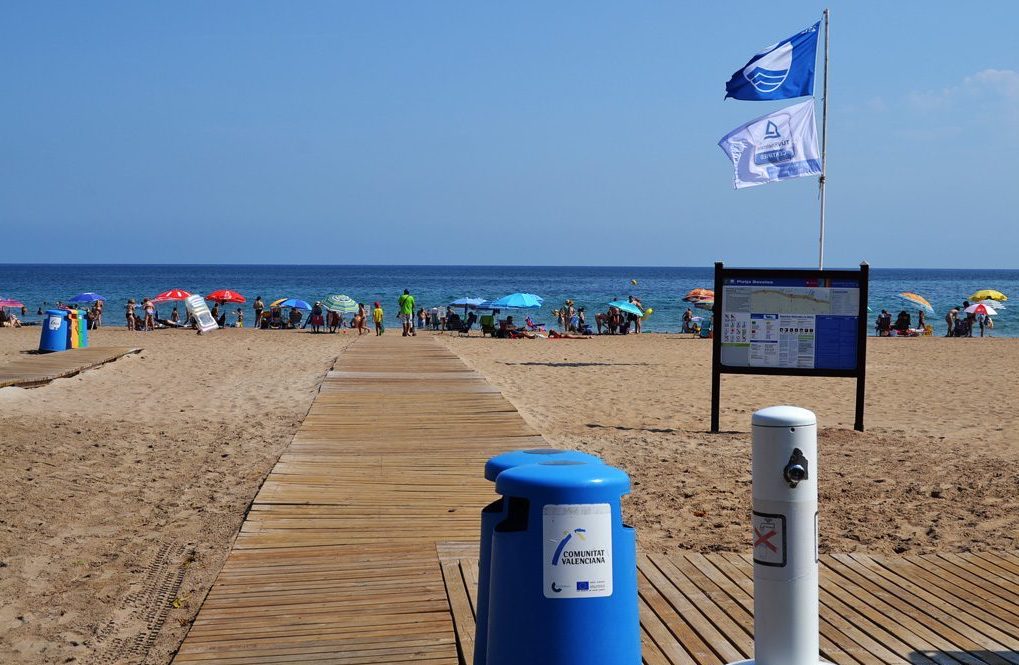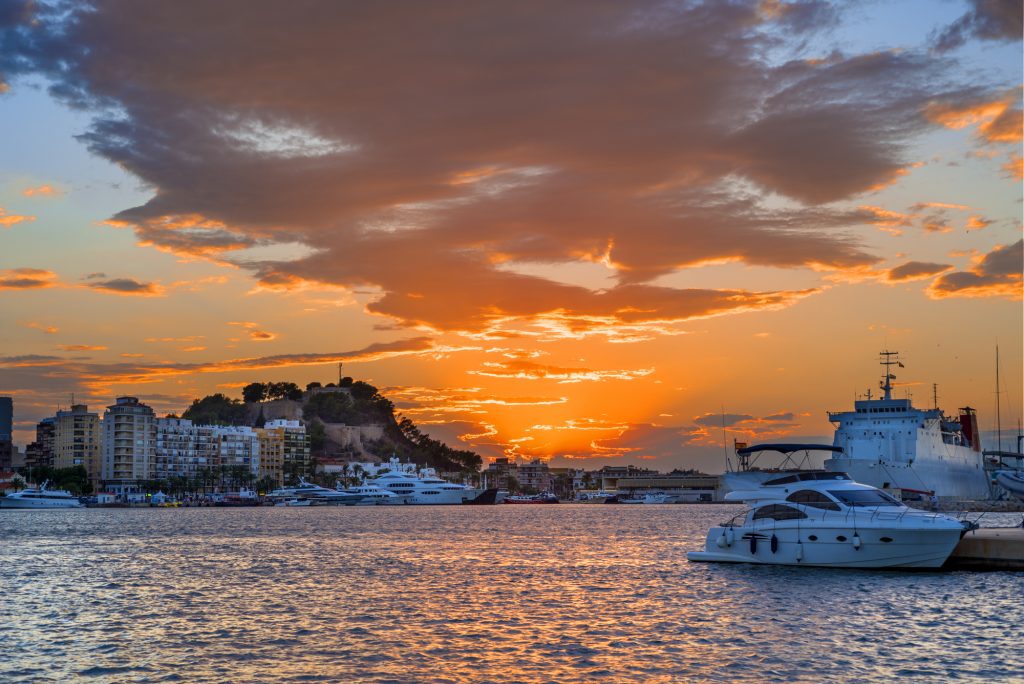Denia is a wonderful resort town in the North of the Costa Blanca, in 2015 it was recognized as the gastronomic capital (Ciudad Creativa de la Gastronomía) of the Mediterranean by UNESCO. However, gastronomy is not Denia’s only advantage. The beautiful town of Denia is a place of attraction for tourists from all over the word, because of its great climate, magnificent beaches, relaxed and pleasant atmosphere. Denia is ideal for both leisure and accommodation for the whole family.
The town has a privileged location between the sea and the mountains, which protect it from cold winds and rainfall. Thanks to that, the weather in Denia is sunny and warm almost all year round. Winters are mild and snowless; there is no such things as rain either. The average air temperature in Denia is 18.3°C. The average sea water temperature from July to September is 25-26°C, in June and October – 22°C, and during the cold months of the year is 14-18°C.
The history of Denia in Spain

Denia is one of the oldest Spanish towns with a rich culture. In its appearance can be found features of many eras and cultures, and a walk down the historical center is a real journey into the heart of ancient.
The settlement in the present-day town of Denia existed at the time of the Iberians, and the town itself was founded by the Romans, having given it the name «Dianum». During the Roman Empire the town was an important naval base and distribution center for goods sailing from Africa to Italy.
In the seventh century, the West Goths settled in Denia. From the VIII to XIII centuries, Denia came under the influence of Muslims, and numerous elements of that era were preserved in the appearance of the town. Under the Muslims Denia was rapidly developing and built up, and its port was of a great importance.
In 1244 Denia was conquered by the Christians under the authority of Jaime I. In the XVII century Denia acquires the status of town, and in the XIX century it enjoys economic prosperity due to development of production and trade in raisins. Raisins from Denia were delivered to many cities in Europe, but at the beginning of the XX century, the vineyards of Denia was affected by epidemic of philoxera and raisin production almost disappeared.
At the same time, the production of toys began to develop in Denia, and in the 60s of the XX century Denia began rapidly to gain popularity as a tourist destination. In addition, fishing is actively developing here.
Denia, Spain: attractions

Walking through the historical center of Denia is a real time travel. On the main street of the town – C/ Marqués de Campo – you will find beautiful buildings of great historical value, shops and restaurants offering excellent local cuisine (Have you not forgotten that Denia was recognized as the gastronomic capital of the Mediterranean?).
In the heart of the town is also the municipal market (Mercado Municipal), Plaza del Convento, where the church Iglesia de San Antonio is, which is part of the archaeological ensemble Convento de San Antonio de Padua of the XVI century. In the historical center you will find two more churches – Iglesia de Nuestra Señora de Loreto of the XVII century and Iglesia de la Asunción of the XVIII century.
For those interested in history, there is the Ethnological Museum in Denia, located at C/ Cavallers, nº 1 in a building that is a reconstruction of a typical house of the bourgeoisie of the XIX century. Museum admission is free. It is open daily except Monday, from 10.30 to 13.00 and from 16.00 to 19.00. On Sunday the Museum operates only in the morning.
Another interesting Museum is the Toy Museum of Denia (Museo del Juguete), which is placed at the old railway station Dénia-Carcaixent and presents the history of the toy industries in the town since 1904, when toy production began to work.

Raising to the castle of Denia, you will go along the ancient quarter of Les Roques (Hospital, San Francisco, San Cristóbal, Guante and Salto streets), which will surprise you with its narrow streets and traditional low houses. The quarter has Muslim origins, but in the era of Christian rule its appearance has changed fundamentally.
Another great place for walking is the old fishing neighborhoods – Baix la Mar, located near the sea. This is one of the most brightly and picturesque neighborhoods of Denia with beautiful squares (Sant Antoni, Rlaza de la Creu), colored facades of traditional low houses and many charming reaches.
In the coastal part of the town, you will find the Boulevard Explanada Cervantes, named after the famous writer, who landed in Denia after his trip to Algeria in 1580. At the end of the Boulevard is placed an unusual monument – a monument to the wonderful climate of Denia – El Monumento al Clima.
The port of Denia is one of the most important on the Costa Blanca. From here ferries reach Ibiza and Majorca.
Do not forget about the natural attractions of Denia, the main of which is the magnificent Natural Park Parque Natural del Montgó – a real paradise for fans of hiking, mountains and natural beauty. Important historical and archaeological artifacts have been found in the caves on the slopes of Montgó (Cova de l’aigua, Cueva de Las Calaveras): Iberian, Roman and Arabic ceramics, fossils of ancient animals, etc. 25 km from Denia are the caves Canalobres, famous for their amazing mineral formations.
The Castle Of Denia

The castle of the X-XI century, located in the center of the town, in the quarter Les Roques, next to the town hall, is one of the main attractions of Denia. The fortress was founded during the Muslim rule in Spain, on the site of an ancient fortification and served as an important strategic point for the defending the town.
In 1244, when Jaime I conquered Denia, the castle passed into the hands of the Catholics, who made their own adjustments to the structure of the castle. As a result, the appearance of the fortress combined elements of several cultures. The architecture of the castle stands out the towers Torre del Consell of the XV century and Torre del Mig of the XI century. The latter is a fine example of military construction of antiquity. Of great interest is the Bastion – an example of Renaissance architecture.
Part of the castle is the Governor’s Palace (Palacio del Gobernador), where today the municipal Museum houses, telling you the story of the town since the ancient Iberians.
In addition to the fortress itself, an important role in protecting of the town was played by the fortress wall, which surrounded Denia in ancient times. The ruins of this wall have survived to this day. You can walk up to the castle on foot or by tourist train (vehicle access is prohibited a few years ago).
Operating hours of the castle of Denia
- November-March: 10.00-18.00.
- April-May: 10.00-19.00.
- June: 10.00-19.30.
- July 1-September 15: 10.00 – 00.30.
- 16-30 September: 10.00 – 20.00.
- October: 10.00-18.30.
Price
- Basic rate: €3.
- For residents of Denia and children up to 8 years: free
- For children from 8 to 16 years: €1.
- For students and pensioners, groups of more than 10 people: €2.
Castillo de Dénia on the map:
The Beaches of Denia

The beaches of Denia are another important attraction of the town, drawing many tourists from around the world. Everyone will find a place for a wonderful holiday among magnificent sandy beaches and picturesque rocky bays of Denia.
There are six Blue flag beaches in Denia: Les Bovetes, Les Marines, Els Molins, Punta Raset, Marineta Casiana, Les Deveses.
The beaches of Denia are located in two zones: most of the sandy beaches, ideal for families, are located in the area of Les Marines, and you will find the picturesque rocky bays and beaches, perfect for diving, snorkeling and secluded relaxation in peace with nature (including nudist) in the area of Les Rotes.
The only exception in the Les Rotes zone is La Marineta Cassiana beach, located next to the port, which is a sandy municipal beach. The other beaches and bays in the Les Rotes area are located within the natural marine reserve. That is why in order to practice diving on these beaches, you need to get permission from the Dirección Territorial de Agricultura, Pesca, Alimentación y Agua de Alicante (tel. 012/ 963 866 000). The number of permits is limited by 15 per day.
Beaches in the Les Marines area:
- Punta del Raset.
- Les Marines.
- Les Bovetes.Els Molins.
- L’almadrava.
- Les Deveses.
Beaches in the Les Rotes area:
- La Marineta Cassiana.
- El Trampolí.
- Punta Negra.
- Arenetes.
Read more about the beaches of the Costa Blanca in our article.
Real estate in Denia

Real estate in Denia is perfect both for your own living and for investment in order to make a profit on rent. Foreigners buy housing in Denia either to live here permanently, or to spend their holidays here. In any case, investment in property in Denia would be amply repaid: the cost of real estate in the town is constantly growing, as well as the demand for it. The fact that there are few hotels in the town plays into the hands of homeowners who rent out their property for tourists.
The average cost of housing in Denia, according to the portal idealista in December 2019, is €1 985 per square meter. As for the districts of the town, the average price per square meter of housing in ascending order is as follows:
- The Saladar – €1411.
- Centro Urbano – €1610.
- La Xara – La Sella – €1783.
- La Pedrera-Vessanes – €1819.
- El Montgó – €1988.
- Les Marines/Las Marinas – €2126.
- El Puerto – €2121.
- Devesses-Monte Pego – € 2326.
- Les Rotes/Las Rotas – €2540.
The most expensive and prestigious district of Denia is Les Rotes (Las Rotas). It is located in the southern part of the municipality in the coastal zone. The real estate market in Les Rotes is mostly represented by luxury housing of low-rise buildings (villas, houses, cottages, etc.) of high price category.
Those who are looking for a house or villa in Denia, but do not have an unlimited budget, can consider for themselves the district El Montgó, located at the foot and on the slope of mount Montgo. The choice of houses here is quite large, and the price is much lower than in Les Rotes: €1988 against €2540 per sq. m. Small house in the area of El Montgó can be purchased at a price of €76 000.

If you are looking for apartments or bungalows near the sea for yourself or for rent, the area of Les Marines (Las Marinas) will be right for you. The average price per square meter of real estate here is not low (€2126 per square meter), but you can find good options for a modest home at a price of €55 000.
For those who are considering for themselves the purchase of housing in a new building, the best fit areas Devesses-Monte Pego, Les Marines/Las Marinas, La Pedrera-Vessanes, where the choice of new housing, mainly apartments and apartments is especially wide.
The most affordable housing in Denia can be found in the areas of Saladar and Centro Urbano. The average cost per square meter of residential property in these areas is €1411 and €1610 per square meter, respectively. Here you will find quite a lot of choice of budget apartments, but there are very little houses for sale in these areas.
In general, real estate in Denia on the secondary market can be purchased starting from €55 000. It will be a modest one-bedroom apartment or a studio. The cost of new housing in Denia starts from €115 000, and this housing is very different in terms of quality and comfort from the secondary, of course, for the better.
If you are planning to buy a house in Denia for yourself and your family, especially if you are going to live here permanently, it would be better to give preference to a new building. Although the cost of new housing in Denia is much higher, its quality guarantees you absolute comfort, of course, if you choose a good developer who builds housing in accordance with the highest quality standards, from the best materials, using the latest technologies.
For rent you can buy inexpensive secondary housing near the sea. With a small investment, it can bring a stable and quite a high income all year round.
It is worth noting, that there are no bad neighborhoods in Denia: all areas are well suited for purchasing housing, and the choice depends only on your preferences and budget.
The catalog of housing in Denia from the company «Alegría» can be found here.



